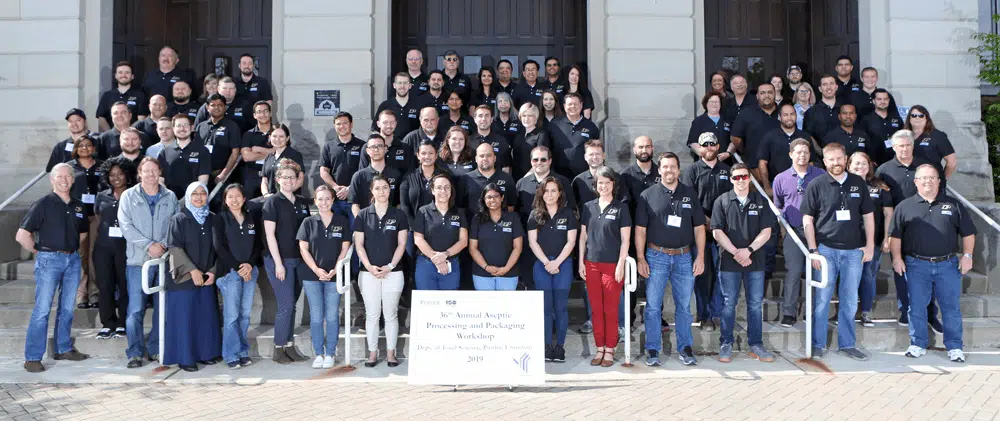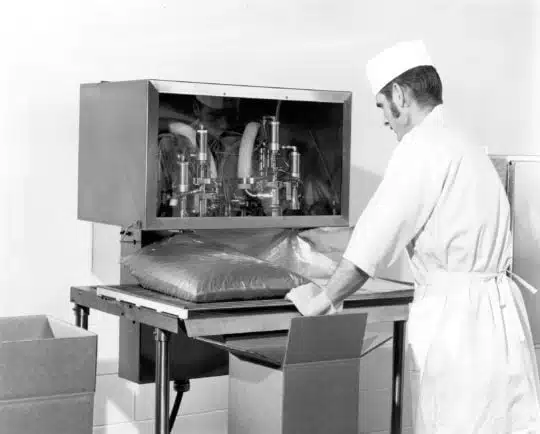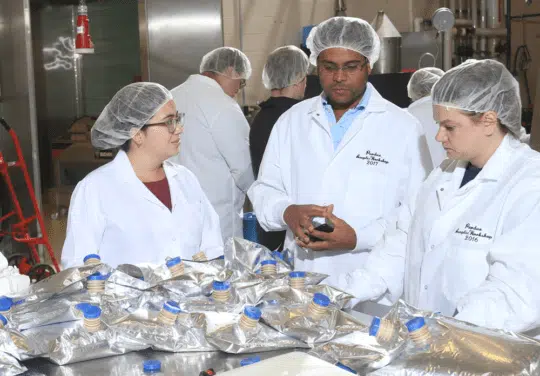Partners In Innovation - Scholle IPN and Purdue

We’ve been collaborating with Purdue for decades, investing in the future of aseptic packaging
Innovation comes through partnership. Scholle IPN is proud of the work we’ve done in collaboration with Purdue University’s Department of Food Science to explore the potential of aseptic packaging. By working with Purdue’s accomplished team of professors, scientists, and researchers, we hope to help inspire the next generation of thinkers who will continue to revolutionize how food is delivered to people.
 Scholle IPN’s relationship with Purdue runs deep. Our founder, William R. Scholle graduated from Purdue in 1938 and founded the Scholle Chemical Company in 1947, inventing the bag-in-box along the way to dispense battery acid. Shortly thereafter, he went back to Purdue and teamed up with Phil Nelson to develop technology that combined the newly designed bag-in-box with Nelson’s work on aseptic storage. Soon, their work was utilized to transport fruit and vegetable products across the world safely, paving the way for new food systems based on storing and conserving large amounts of food in shelf-stable packaging. Purdue’s Food Science department builds on that work, looking for cutting-edge ways to bring food safely to others.
Scholle IPN’s relationship with Purdue runs deep. Our founder, William R. Scholle graduated from Purdue in 1938 and founded the Scholle Chemical Company in 1947, inventing the bag-in-box along the way to dispense battery acid. Shortly thereafter, he went back to Purdue and teamed up with Phil Nelson to develop technology that combined the newly designed bag-in-box with Nelson’s work on aseptic storage. Soon, their work was utilized to transport fruit and vegetable products across the world safely, paving the way for new food systems based on storing and conserving large amounts of food in shelf-stable packaging. Purdue’s Food Science department builds on that work, looking for cutting-edge ways to bring food safely to others.
Along with funding an endowed chair in the Purdue University Department of Food Science, Scholle IPN has also donated resources over the years, including a bag-in-box filler to be used for both student education, industry trials, and continuing research. Recently, we gave a new, state-of-the-art aseptic sterilization tunnel to Purdue’s lab in order to encourage innovation. “We know what we do, we know what works. But to really understand the complete space [of aseptic technology], we’re asking Purdue to explore all the variables surrounding it and help define the discipline,” says David Bellmore, Director of Technology for Scholle IPN. In particular, the Scholle family wanted to invest in the institution that first inspired William and pass along the tradition of innovation and education. “Purdue helped William Scholle with his bag-in-box technology and when he passed, his family wanted to show their appreciation.”
 Notably, Purdue hosts yearly workshops to train industry professionals on the ins and outs of aseptic packaging—they go through the nuances of chemical reactions, nutrient degradation, enzymatic reactions, color, flavor, and process engineering. “We have an aseptic processing and packaging training that’s been ongoing for the last 35 years,” says Dharmendra K. Mishra, Assistant Professor of Food Science, a worldwide authority on acidified and low-acid foods, and facilitator of many of these workshops. Along with developing new technologies, the workshops also encourage independent and creative thought, often becoming a hub for folks to exchange ideas. “I started another one, which is the validation of aseptic processes—lots of folks from Scholle IPN attend every year. In that training, we teach people to ask, ‘how do we validate our processes?’ If you have a filler, for example, how do we validate a filler for commercial sterility?”
Notably, Purdue hosts yearly workshops to train industry professionals on the ins and outs of aseptic packaging—they go through the nuances of chemical reactions, nutrient degradation, enzymatic reactions, color, flavor, and process engineering. “We have an aseptic processing and packaging training that’s been ongoing for the last 35 years,” says Dharmendra K. Mishra, Assistant Professor of Food Science, a worldwide authority on acidified and low-acid foods, and facilitator of many of these workshops. Along with developing new technologies, the workshops also encourage independent and creative thought, often becoming a hub for folks to exchange ideas. “I started another one, which is the validation of aseptic processes—lots of folks from Scholle IPN attend every year. In that training, we teach people to ask, ‘how do we validate our processes?’ If you have a filler, for example, how do we validate a filler for commercial sterility?”
Because Purdue is known for their aseptic research, companies regularly reach out to Dr. Mishra and his team to test packaging solutions, throwing new challenges that provide the framework for forward-thinking ideas. “When you are in commercial manufacturing, it’s really hard to do any small-scale trials, and you have to end up using lots of product,” Dr. Mishra shares. “For small trials in our facility, we can run as low as 30 gallons (114 liters) for one batch.” This is not the type of testing you’d see done if a company was submitting a product to the FDA, for example, but having access to a small-scale testing facility means that companies across the globe can continue to innovate on creative packaging solutions and receive critical feedback along the way.
We’ve spent decades collaborating with Purdue, providing them with equipment and working to tackle new problems in the aseptic packaging sector. Recently, Dr. Mishra worked with us on pouches, a format that is technically difficult to execute well. “Pouch filling was really difficult in terms of sterilization of the pouches,” he notes, “and Scholle IPN came up with this really nice idea of how we can aseptically fill pouches so we can have really good quality food products that we can fill in pouches.”
It’s hard to overstate the importance of aseptic packaging. Not only has aseptic packaging made the transport of large amounts of food possible, but it’s done so without compromising what’s being protected. This is especially pivotal when you think about food waste and the global food supply. Because food is subject to the effects of climate variations, a farmer can have a great harvest one year and a devastatingly low one the next. Aseptic packaging can help deflect some of that impact by providing storage solutions from particularly bountiful years, defraying the effects of less prosperous harvests.
Likewise, aseptic packaging enables global distribution of goods that would ordinarily rely on cold chain—food can simply be sent around the world to areas affected by drought, famine, and other disruptors of a city or nation’s food supply. Instead of wasting food excesses, aseptic packaging can help save astronomical amounts of food and redistribute them to places that need them.
The potential of aseptic packaging has yet to be fully realized, and Scholle IPN will continue to work with Purdue to push forward new ideas and find ways to make aseptic packaging even easier to use and implement. “Aseptic is such a good and unique technology,” Dr. Mishra says. “we have the technology, it’s the adoption of technology [that matters].”
